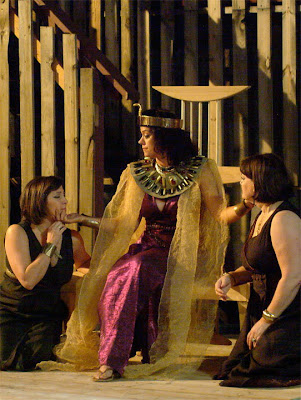*Antony and Cleopatra* Reviewed in *Shakespeare Bulletin*

The following are excerpts from Darlene Farabee’s review of the Fall 2010 Flatwater Shakespeare Company production of Antony and Cleopatra in Shakespeare Bulletin 29.2 (Summer 2011): 196-99.
[In the Flatwater Shakespeare Company version, Antony and Cleopatra were] two strong people vying for power in the relationship at the same moment they were vying for power in the world.
This arrangement of the playing space [in the Swan Theatre], I found, affected the audience in interesting ways. For one thing, we were always seeing one another; even if one was not looking at individual audience members, part of the backdrop was always other spectators. This fact helped emphasize Cleopatra’s comments that refer to her own theatricality. Additionally, it meany that some scened could be played with an actor downstage directly facing an actor upstage, a profiling that worked particularly well with the messenger-scenes and the discussions between Antony and Cleopatra.
Melissa Lewis Nuss as Cleopatra clearly reveled in her role, in the same ways that Cleopatra revels in her role as Queen . . . most of all, she was believable as Cleopatra.
Antony’s army generally gave the appearance of lithe, taut strength rather than bulky solidity. Some of this impression depended on the fact that Vince Learned (Antony) is tall and rather wiry; but the production seemed to emphasize a lean strength for Antony and his followers and an accountant-like carefulness for Caesar [Scott Herr].
Enobarbus’s description [as delivered by Nathan Weiss] of the wonders of Cleopatra’s attractions conveyed the oddity of how his complete admiration combined with his awareness of her vagaries. Maecenas [played by John Marinovich] sat on the ground, rapt by the spell of Enobarbus’s description, and the audience seemed particularly taken with the imagery as well.
[Through] an ingenious bit of staging [by director Bob Hall] . . . Antony, loaded on a litter and borne carefully, was brought to Cleopatra who was raised only on the large impressive chair that earlier had served as a throne. In a carefully choreographed movement, Mardian [Daniel Kubert] and the Soothsayer [Dustin Witte] stretched a long scrim as a wall separating Cleopatra upstage from Antony lying on his litter downstage. After being brought to the scrim “wall,” the litter-bearers raised him as the scrim-holders lowered the barrier . . . [T]his canny bit of stage business . . . called attention to the possibilities in the production for a complete shifting of the realities of, well, gravity, for one thing. This vertical flexibility merged well with the play’s reliance on continual shifts between locations. The open-air theater also helped convey an impression of openness and continual motion.
Shakespeare Bulletin is North America’s leading scholarly journal on Renaissance drama in performance. The journal website is www.press.jhu.edu/journals/shakespeare_bulletin/. Darlene Farabee is Assistant Professor of English at the University of South Dakota; her essay in this issue also includes a review of Nebraska Wesleyan’s Romeo and Juliet, November 2010. We are grateful to Professor Farabee and the editors of Shakespeare Bulletin for permission to share these excerpts.
Photo: Noelle Bohaty as Iras, Melissa Lewis Nuss as Cleopatra, and Dawn Marie Moe as Charmian in Flatwater Shakespeare's Antony and Cleopatra, directed by Bob Hall. Photo Credit: John Nollendorfs.
